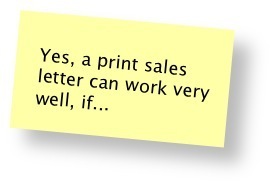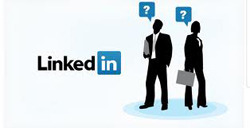Steve Slaunwhite's Blog, page 4
January 23, 2014
Do “snail mail” sales letters still work?
During a workshop recently, a participant asked me if an old-fashioned snail mail sales letter still works for generating leads.
I answered the question with a question. “How many here found out about me as a result of a letter I sent them?”
 Out of a group of 31, three raised their hands.
Out of a group of 31, three raised their hands.
That might not sound very impressive. In fact, that example might confirm your suspicion that a direct mail letter is a dinosaur of a marketing tactic that doesn’t fit in today’s online world.
Not so fast.
You see, in addition to those three who came to my workshop by way of a sales letter, I have two private consulting clients who found out about me that same way.
Sales letters can be an effective lead-generator — if you use them correctly.
I use sales letters regularly in my own business. And I write them for my private clients as well.
Here are just some of the things I’ve learned over the years about getting a good response:
Use a highly targeted list filled with ideal prospects. In fact, I wouldn’t bother with any other kind.
A two-page letter tends to work best. Yes, I know that flies in the face of current “no one reads more than a page” wisdom. But for me and my (mostly B2B) clients, the two-pager is often the winner.
The more a letter looks and reads like an actual letter – and not a polished marketing piece – the better it works. No surprise there.
Lumpy letters (with something inside, like a stylus pen) get opened more often. However, the freebie or gimmick often gets all the attention and the prospect never reads the letter! I prefer to focus instead on writing a great sales letter and having it stand on its own merits.
Don’t force the prospect to reply only via a website landing page. Also provide the option to call or email. Phone and email responses typically come from higher-quality prospects.
Of course there are many other tips and tricks for creating a marketing letter that brings in the business. Those are just a few.
So if you’re not currently using a persuasive, inviting letter to call on prospects, consider it. You might discover it works well for you, at least as a supplement to your other sources of leads.
January 16, 2014
Writing white papers (and special reports)
I posted a great interview with Gordon Graham yesterday on my other blog at the Copywriting Training Center. Gordon is the leading expert on conceiving and writing white papers (as well as its close cousin, the special report).
This is a Podcast-style interview (just 10 minutes) with lots of practical, no-fluff tips. If you’re at all interested in using white papers and special reports to promote your business, this recording is worth a listen.
And you can do that right here.
Enjoy!
January 8, 2014
How to write copy, faster
I just posted a new article on my blog over at the Copywriting Training Center. It’s about me trying to write a web page to promote a new program, and finding the writing process slow and painful.
Can you relate?
The article is geared toward professional copywriters, but if you write copy for your own business then you’ll might find the 3-step strategy I talk about for writing faster (and better) useful.
You can read the blog article here.
Enjoy!
October 2, 2013
Teleclass series on no-hype copywriting
Last week I was Marcia Yudkin’s guest on her No-Hype Copywriting Summit. I’m a big proponent of marketing copy that doesn’t resort to hype to persuade and sell. So I was glad to participate.
Today, I’ll be joining Marcia again, as well as the other copywriting speakers, on a Q&A call. We’ll be answering questions from the audience.
If you read this post in time, perhaps you can join us? Otherwise, you can purchase all the summit recordings here:
September 11, 2013
How to ask your client for a raise
I was chatting with a copywriter earlier this week who had a question I’ve been asked dozens of times before. “How do I increase my fees with a current client?”
That’s a tough one. After all, you don’t want to lose the goodwill you’ve built up with that client. Nor do you want to jeopardize any future work that might otherwise come your way.
So how do you ask for a raise?
Say, for example, you landed a client five years ago when you just launched your writing business. Your rates were low back then — perhaps too low. (Hey, you were just starting out!)
But now your fees are much higher. And you want to do something about that older client who continues to benefit from your services at bargain-basement prices.
There are a few things you can do.
First — and this may surprise you — you could keep the rates for that client just as they are. That’s right. Don’t change a thing.
I have a client who started with me eight years ago. My rates have increased considerably during that time, but I’ve never raised his rates. He pays the same today as he did eight years ago.
And he knows it.
I’ll probably never raise his rates. The work is still profitable for me. And the client is so loyal that I expect to be working with him for another eight years.
Why would I mess with that?
That being said, you still might want to increase your rates with a current client. If so, here’s a strategy that tends to work well.
First, let the client know that your rates will be increasing on such and such a date. (Make “such and such” at least two months away.)
Then, explain that because he’s such a valuable client, you’re going to give him a two-month extension. (So his rates won’t actually increase for four months.)
That’s it. A very simple strategy, I know, but effective. In fact, assuming that your price increase is reasonable, most clients will be fine with it — and appreciative of the extension.
“How much of an increase is reasonable?” you might be asking. In my experience, most clients will accept a 10-15% increase in fees. Maybe even 20%.
But not much higher.
Most clients will balk at a 100% increase, for example, even if the higher fee is justified. (Imagine how you’d react if your babysitter announced her rates were doubling!)
So, plan ahead, keep your fee increase modest, and use the above technique. In most cases, you’ll get the “raise” you deserve.
July 17, 2013
Do You Really Need Business Goals?
Click here to subscribe in iTunes; or, listen to the audio version below:
Just about every business success book I have ever read claims that you need to set high goals. “Make your goals ambitious,” one book advises. “Always be reaching for the stars!” says another.
For example, as a self-employed professionals, one of your goals might be to increase your income by 50%, or land a new F-500 client, or double your productivity.
 But wait a minute. Do you really need goals? Must you always be pushing hard toward some specific target, like an Olympiad going for the Gold?
But wait a minute. Do you really need goals? Must you always be pushing hard toward some specific target, like an Olympiad going for the Gold?
What if you just kept doing what you’re doing now? Wouldn’t the momentum you’ve already created in your business naturally take you where you want to go — without the added oomph (and stress) that comes from pursuing an ambitious goal?
Here is an exercise that was recommended to me a few years ago by Harold Taylor, a time management expert.
Make two lists.
On List #1, write down where you will be in five years if you just kept doing what you’re doing now and didn’t set any particularly challenging goals.
If you’re a copywriter, for example, you would expect your income to increase 15-20% over that time period simply because you’ll be gaining more experience, becoming more business savvy, writing better, quoting better, and attracting better paying clients. No goals required. Just keep doing what you’re doing and you’ll get there.
Now on List #2, write down where you WANT to be in five years. How much money do you want to be making? How many hours per week do you want to be working? What sort of clients do you want to be working with?
Now take a cold, hard look at both lists.
Ask yourself: Am I on the right track? Or is there a serious gap between where I want to be versus where I’m going?
Let’s say list #1 indicates that in five years your income will be 15% higher, and list #2 says the same thing — that you want that increase in income. If that’s the case, then you really don’t need to set any big goals. Just keep on truckin’!
Of course, that doesn’t mean you can rest on your laurels. You still need to plan. You still need to be always improving ever aspect of your business. But what you won’t need is a series of Herculean objectives. The road you’re already on, and the pace you’re traveling on it, will naturally take you where you want to go.
But what if List #2 indicates that you want to double your income? Or work 30% fewer hours per week but make the same income? Or break into a new niche market or specialty? If any of those are the case, then you’re going to need to make some significant course corrections, changes and improvements.
In other words, you’re going to need to set some ambitious GOALS.
Goals aren’t easy. They take a lot of work. You can expect to put in many extra hours, learn new things, deal with setbacks, face discouragement and lack of motivation, and much more.
But I can tell you that, based on my own experience, working toward your goals –even if you fall short of achieving them — is worth the effort.
I’d much rather work hard to get where I want to be, and not make it, then coast to a place I don’t want to be, and get there.
So try that technique. Make those two lists. Compare them. And if you see there’s a gap, then you know you need to set an ambitious goal to get to where you want to be in your business.
June 26, 2013
Do Special Reports Still Work?
Click here to subscribe in iTunes; or, listen to the audio version below:
I admit it. I’m a card-carrying enthusiast when it comes to special reports. In fact, I offer several free reports to those who subscribe to this e-newsletter at SteveSlaunwhite.com or CopywritingTrainingCenter.com.
I also write and produce special reports for my clients.
Yet, just the other day, I received an email from a business owner who asked –rather grumpily — “Come on, do special reports really work anymore? I never read the darned things. I’m sure my clients don’t either.”
I hate to admit it. But he makes a good point. I sign up for special reports all the time. Yet many of them are still sitting somewhere on my computer, unread.
Does that mean creating a special report for your business is a waste of time?
Not necessarily. Take a closer look at what a special report is designed to do.
First, it’s designed to position you (or your company) as an expert.
For example, a few years ago I worked with a freelance copywriter, S.J., who wanted to offer case study writing services. To attract clients she created a special report called, “9 Powerful Strategies to Get Customers To Say Yes To Case Studies.” She got a designer to create a nice cover for it. Then she put a thumbnail of the report on her website, along with a sign-up form.
Prospects who visited her website and noticed the report got the immediate impression that S.J. knew a heck of a lot about case studies. That’s no surprise.
But here’s the interesting thing. Prospects who didn’t even sign up for the special report, let alone read it, still positioned her in their minds as a case study writing expert.
That’s the cool think about a special report. It’s like having a framed certificate on your wall that says, credibly, “This is what I’m good at.”
The second thing a special report is designed to do is capture leads.
About 75% of prospects who visit your website won’t contact you right away — even if they have a need for, and are interested in, your services. That’s a problem because if those prospects leave your website, they may never come back.
But if there’s something enticing for them to sign-up for — a high-interest special report, perhaps? — then you’ll at least capture their name and email address so you can follow up and stay in touch.
And, again, if any of those prospects never read your special report, you’ve at least captured the lead.
Finally, a special report is designed to motivate prospects to contact you when they have a need for your services.
This is where it is important for your special report to get read. Those who read it are significantly more likely to contact you and become new clients. I’ve had many clients say they read one of my special reports and it motivated them to call me.
So you see, the fact that “few people read special reports” doesn’t necessarily mean it’s not a good idea for your business. If you need to be seen as an expert by your target audience, and you need to generate leads then, chances are, a compelling, high-interest special report will help you accomplish both.
June 5, 2013
How to Pick a Winning Headline
Click here to subscribe in iTunes; or, listen to the audio version below:
 I’ve been doing a lot of copywriting workshops lately. In fact, I just got back from conducting a training program for a terrific group of marketers in Atlanta.
I’ve been doing a lot of copywriting workshops lately. In fact, I just got back from conducting a training program for a terrific group of marketers in Atlanta.
During the session, one of them asked, “When I brainstorm headline ideas for an ad or blog post, how do I pick the best one?”
Good question.
In fact, that’s a challenge many professionals face – even those who are not copywriters or marketers. You make a list of headline possibilities and then get stuck trying to figure out which one will most likely be a winner.
I wish I had a fool-proof technique for this. I don’t.
However, I do teach a simple process for evaluating headline ideas that works fairly well. I call it The 5 C’s Method.
Say for example, you’re writing a web page to describe and promote a new service you’re offering. You know the headline is crucial, so you dream up a list of possibilities. Which one will likely work best? Using the 5 C’s method, you would ask these questions:
1. Does it COMMUNICATE a benefit?
The best headlines communicate a benefit of some kind. They imply, at the very least that you’re going to learn something, solve a problem, gain a new insight, save money, get a specific result, etc.
I often make the mistake of trying to be too clever with a headline. I once wrote the following headline for a magazine column: Fall In ‘Like’ With Prospecting. The editor disagreed with that approach and changed it to: 4 Steps To Prospecting Success. She was right.
2. Is it CLEAR?
The more clear your headline is, the better. The last thing you want is your target audience struggling to figure out what you’re trying to say. In most cases, they won’t bother.
3. Does it CREATE a sense of urgency?
This is optional. Your headline doesn’t have to convey urgency to work well. But if there is a genuine reason why the reader should act quickly, consider saying so in the headline. It’s no surprise that email subject lines that begin with “Last day…” get such high open rates.
4. Is it CREDIBLE?
It’s easy to get carried away and craft a headline that promises the world. I’m sure you’ve seen your share of over-the-top claims in headlines! But saying “Double Your Client Base In 5 Days – Guaranteed” just isn’t believable. (Sure, we want it to be true, but there is an influential part of our brain that’s saying, “This is B.S.!”)
The best headlines have a ring of truth to them.
5. Is it CREATIVE?
Your headline doesn’t need to be clever or “wow”. But if it is interesting – and perhaps a bit different than what your target audience is used to seeing – then it stands a better chance of gaining their attention.
And when that happens, your web page, email, sales letter or other marketing piece is more likely to get noticed, get read, and get responded to.
So that’s my 5 C’s method for evaluating headlines. Like I said, it’s not foolproof. But it does increase the likelihood that you’ll pick a winner.
Try it!
May 23, 2013
How to Write a LinkedIn Introduction Request
Earlier this week I received the following LinkedIn message from Jill (not her real name):
As a valued fi
 rst-level contact, I respectfully ask you to introduce me to John Smith. Thanks, Jill.
rst-level contact, I respectfully ask you to introduce me to John Smith. Thanks, Jill.
I don’t have a problem with her asking. My contact Jane Smith (not her real name either) is obviously a potential client for her services. An introduction from me is going to make it easier for Jill to get in touch and build that relationship. Through my efforts to connect them, she might even land herself a brand new client.
The problem I have is in the way she asked. She came across as impersonal, even blunt. Worse, I got the impression that her one-sentence request was a “cut and paste” template she regularly blasts to a multitude of contacts.
Definitely not to the best way to get introductions!
If you’re going to ask one of your LinkedIn contacts for an introduction, I recommend you take the time to write a personal message. Explain what your intentions are (LinkedIn actually requires you to do that) and demonstrate that you appreciate the magnitude of the favor you’re asking.
Here’s an example of an actual introduction request sent by a friend of mine. Only the names have been changed.
Hi Debra,
May I ask you for a big favor?
I noticed that you’re connected with Jane Phillips, an Atlanta life coach. As you may know, I now specialize in website design for life coaches and would like to forward Jane some information on my services.
Would you be willing to introduce us?
I realize this is a huge favor. If you don’t feel comfortable introducing us, I understand. You don’t even need to reply to this email. Just ignore it.
But if you can introduce us, thank you!
And please let me know how I can return the favor.
Best,
Phyllis Spencer,
Freelance Designer
Specializing in Websites for Life Coaches
I think you’ll agree that a personal, sincere, appreciative message like that has a much better chance of success. In fact, it did work. My friend got her introduction to Phyllis.
By the way, if a LinkedIn contact agrees to introduce you to one of their valued contacts, be sure to send them a Thank You note. I actually snail mail them a card. You’ve got to show your appreciation!
So when it comes to asking for introductions on LinkedIn, toss the template. Instead, take the time to carefully compose your request. Never forget that you’re asking for a big favor.
You can listen to the audio version of the article here:

May 9, 2013
10 “Bulletin Board Worthy” Copywriting Tips
I was at a dinner party last week and met someone who reads my e-newsletter. (That rarely happens, by the way, but when it does it does wonders for my ego!)
 He said he particularly liked my copywriting tips and asked which I considered were most important. “Give me your top ten…” he said, “ten tips that are worth pinning to the bulletin board next to my desk.”
He said he particularly liked my copywriting tips and asked which I considered were most important. “Give me your top ten…” he said, “ten tips that are worth pinning to the bulletin board next to my desk.”
Whoa. That put me on the spot. I wasn’t sure what to say at first. Then I clumsily went through what I thought were the most important things to keep in mind when writing marketing copy.
Here’s the gist of what I told him.
1. Know your prospect.
The better you understand your target audience, the more likely you are to write a message that persuades them. That’s why the phrase “Bookkeeping Sucks. We Make It Suck Less” worked so well for Less Accounting.
2. Decide what you want the prospect to do.
Like an archer staring at a target, you need to aim your marketing copy at a bull’s-eye. What action (your bull’s-eye) do you want the prospect to take? Sign-up for something? Agree to a meeting? Place an order? The clearer you are about that, the more likely you are to craft copy that’s clear, focused, and uncluttered with extraneous information.
3. Gain attention.
Bob Bly, in one of his books, points out that if your marketing piece fails to gain attention, it fails completely because no one will read the copy. How true. Most often the headline — or in the case of email, the subject line — is what does this work. So make it a good one!
4. Start with the prospect’s problem or goal.
Don’t start a marketing piece with information about your product or offer. Instead, begin with the prospect’s problem or goal. Prospect’s problem: Bookkeeping Sucks. Less Accounting’s software product: We make it suck less.
5. Position your product or offer as the solution.
Now you can introduce your product or offer and describe how it’s a solution to the prospect’s problem, need, or aspiration.
6. Bring out the benefits by asking, “So what?”
You probably know that your marketing copy should focus on benefits. But what the heck are benefits? In my opinion they’re simply answers to the question, “So what?” For example, say your corporate training program can be conducted via webcast. So what? Well, more crazy-busy executives will be able to attend. That’s the benefit.
7. Tell stories.
Stories, examples, scenarios, etc. bring the benefits to life for the prospect. It’s human nature to remember stories and be influenced by them. In fact, if you get stuck while writing copy, try beginning a new sentence with, “For example…” (Just as I did in #6.)
8. Sprinkle on the belief-builders.
People are skeptical of claims made in marketing materials. (Imagine that!) That’s why testimonials, endorsements, specifics, facts and other evidence — what I call “belief builders” — are so important. Sprinkle them liberally throughout your copy.
9. Make it easy to say yes.
Ultimately, you want the prospect to take action – click, call, buy, visit, respond. So make taking that action as easy as possible. Provide clear instructions. Explain why taking action now, rather than later (or never), is such a good idea. If you have a guarantee that reduces the risk, now is the time to mention it.
10. Write conversationally.
Harrison Ford, struggling with some lines during the filming of Star Wars, famously said, “You can write this s–t, but you can’t say it!” Can you say your copy? Try reading it out loud. Is it a message you could comfortably, confidently and conversationally say — in person — to your prospect? If not, revise it.
So those are the best tips I could think of on the spur of the moment. How did I do? Are those tips you would have given that dinner party guest? Or did I miss other, more important ones?
Let me know. (Please comment below.)



